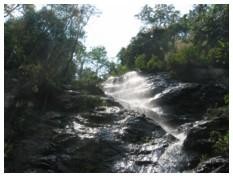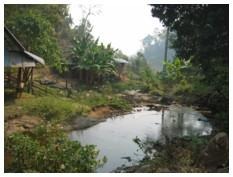|
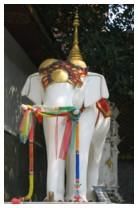 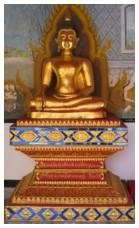
Chiang Mai is situated in the North of Thailand, about 700 kilometers or a
one hour flight away from Bangkok, and it is the second most important
city of Thailand. It has more than 300 temples - and we managed to see
only one, which was a big victory on the kids. They thought already one
visit was very, very boring.
Chang Mai was founded in 1296 by King Mengrai. Its name means new (walled)
city; Chiang Saen means old city, this town used to be the main city in
the north of Thailand until Chiang Mai took over this function. In
1345, Chiang Mai became the capital of the Northern Thai kingdom of Lanna
(land of a thousand rice fields). In the centuries between then and now,
the ownership shifted between Burma (now Myanmar) and Central Thailand,
with also periods of self-control. In 1775, the area was incorporated into
the Thai Kingdom by King Taksin. In 1933 only, Chiang Mai became a
province of the Kingdom of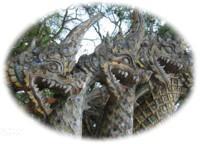 Siam. Siam.
One of the main tourist attractions is the Wat Prathat Doi Suthep or Doi
Suthep temple. This temple
is the source of all sorts of legend, one of the most famous one being
about an elephant. A
14th-Century monk from Sukhothai saw a fire in a vision and when he
followed it, he found a bone from Buddha himself. He took the bone to his
king, but it showed no magical powers and the king, as a result, showed no interest. The
king of Lanna however may have had a vision of future tourism and
invited the monk to Chiang Mai and offered to enshrine the bone. He
had a special house built and preparations were made put the bone in. The
bone appeared now to be not so strong as you might have expected of a
Buddha-bone and it broke in two. The king then placed the second half of
the bone on
the back of a sacred white elephant, at the northern gate of the city, now
known as Chang Puak (white elephant gate). The elephant was sent
off to the wilderness. The elephant was as strong as the bone and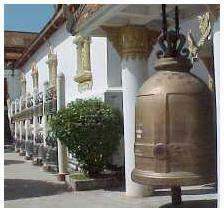 didn't
finish his task. The poor didn't
finish his task. The poor
 animal climbed
the slopes of Doi Suthep, and dropped dead before it reached the top. On
this place, in 1383, the king built the Doi Suthep temple. The name of the
mountain used to be Doi Aoy Chang (Sugarcane elephant mountain) but was
named later Doi Suthep after the hermit Sudeva, who lived on the slopes. The white
elephant is
still standing there, watching over the temple and the bone (see top
picture). animal climbed
the slopes of Doi Suthep, and dropped dead before it reached the top. On
this place, in 1383, the king built the Doi Suthep temple. The name of the
mountain used to be Doi Aoy Chang (Sugarcane elephant mountain) but was
named later Doi Suthep after the hermit Sudeva, who lived on the slopes. The white
elephant is
still standing there, watching over the temple and the bone (see top
picture).
As the temple lies 1676 meter above the city of Chiang Mai, you can
imagine that even for an elephant this is no pleasure trip. The first part
can be done by road nowadays, but for the last part you still have to
climb the stairs, no less than 300 steps. Not an easy task for an
elephant, but also not for a human being, especially if you have to carry
a heavy Anna-load.
The temple has elements of Buddhism and Hinduism in it, as most of the
temples in Thailand do. The temple is not only a tourist attraction, as
many Buddhists for all over the world come here to pay there respect to
Buddha.
The walls of the temple are lined with bells. There are signs "Don't
push the bell" everywhere, which only seems to encourage people to
make the bells sound. However, maybe the signs only mean that you can ring
the bell, but not push it?
|
|
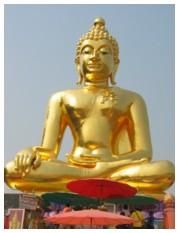 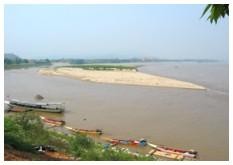 One
of the places tourists in Chiang Mai are recommended to go is the
"Golden Triangle". Well, maybe it was golden in history, when
opium trade still freely took place. Nowadays the only golden thing there
is a huge Buddha, and surely there is no real gold involved. You can
estimate its size by looking at the tiny human beings on its foot, under the
umbrellas. It took us 5 hours by car to get there and we did not find a
lot of interesting things there. It is the border between Thailand,
Myanmar and Laos, separated by the Mae Khong river. Boats are waiting to
take the tourists to the other two countries, even though they look
exactly the same from the Thailand point of view, except for the casino
which can be found on the Myanmar side. The tax haven which was envisaged
in this triangle hasn't reached big heights yet. One
of the places tourists in Chiang Mai are recommended to go is the
"Golden Triangle". Well, maybe it was golden in history, when
opium trade still freely took place. Nowadays the only golden thing there
is a huge Buddha, and surely there is no real gold involved. You can
estimate its size by looking at the tiny human beings on its foot, under the
umbrellas. It took us 5 hours by car to get there and we did not find a
lot of interesting things there. It is the border between Thailand,
Myanmar and Laos, separated by the Mae Khong river. Boats are waiting to
take the tourists to the other two countries, even though they look
exactly the same from the Thailand point of view, except for the casino
which can be found on the Myanmar side. The tax haven which was envisaged
in this triangle hasn't reached big heights yet.
Before 1959, opium was grown and traded there, but after
that it was forbidden and the government of Thailand went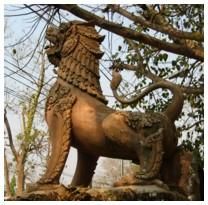 through a lot of
trouble to follow up the legislation. As a result, people who used to live
here and grow opium, now have moved down and are selling souvenirs to tourists. Their
incomes have become a lot lower. They still wear their clothes from former
days, warm jackets for the mountain cold, even though the villages where
they live now are mostly very hot. Maybe it is the tradition, but it could
also be lack of money that prevents them to buy more suitable clothes.
through a lot of
trouble to follow up the legislation. As a result, people who used to live
here and grow opium, now have moved down and are selling souvenirs to tourists. Their
incomes have become a lot lower. They still wear their clothes from former
days, warm jackets for the mountain cold, even though the villages where
they live now are mostly very hot. Maybe it is the tradition, but it could
also be lack of money that prevents them to buy more suitable clothes.
 The road up there is nice and has beautiful nature; the place itself has
only the enormous Buddha and more souvenirs. Apparently there are also
some temples to be found there, but as the enthusiasm of our children for
temples had already faded, we decided to leave them for what they were.
Next to every cultural inheritance there were compelling signs as well,
which basically kept us away instead of encouraging us to buy valuable
souvenirs. Maybe a sign "no shops here" would help! The road up there is nice and has beautiful nature; the place itself has
only the enormous Buddha and more souvenirs. Apparently there are also
some temples to be found there, but as the enthusiasm of our children for
temples had already faded, we decided to leave them for what they were.
Next to every cultural inheritance there were compelling signs as well,
which basically kept us away instead of encouraging us to buy valuable
souvenirs. Maybe a sign "no shops here" would help!
During this trip we also visited the remnants of Chiang Saen (old city),
the old capital of Northern Thailand. It lies on the borders of the Mae
Khong river and was established in the 6th century by King Singhanuwat,
one of the first Thai leaders. And even King Mengrai in the 13th century
used to retreat from Chiang Mai to Chiang Saen whenever trouble was ahead.
Apart from the lion (or other animal?) guarding the old city, there was
yet another temple for Buddha. This one did not make us any happier, as it
carried a sign: "Lady no entry".
Elodie
stepped into the temple, as she saw no reason why ladies should not see
Buddha, and she was not a lady anyway. For this occasion, she conveniently
called herself "Just a girl". |
|
We also went trekking for three
days in the mountains north of Chiang Mai. Even though some of our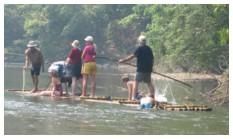 fellow trekkers doubted our sanity since we did this with a two year old
(and they did not hesitate to make their remarks just loud enough for me
to hear them), everything went very smoothly. The longest walk we made was
three hours, with Anna in the backpack with Teb. We arrived more than one
hour ahead of our complaining fellows.
fellow trekkers doubted our sanity since we did this with a two year old
(and they did not hesitate to make their remarks just loud enough for me
to hear them), everything went very smoothly. The longest walk we made was
three hours, with Anna in the backpack with Teb. We arrived more than one
hour ahead of our complaining fellows.
The mountains were beautiful and so were the villages where we slept. No
electricity or running water, so you had to shower in a mountain stream
(not so easy if you did not bring your bathing suit and the stream forms
the center of the village). The villages are inhabited by the Karen tribe,
a tribe that lives in the North of Thailand and in Myanmar. There are
probably around 300,000 Karen in Thailand and they were on of the first
people to live there.
The "longneck" Karen are a tourist attraction, they were many
golden rings around their neck. This tradition does not exist any more and
apparently it is only done by a minority to attract tourists.
The Karen wear mainly bright red clothes for which they weave and
embroider the fabric themselves. In the village, pigs, cows, ducks and
chickens were running around. But you could also find remnants of modern
life, since many tourists before us of course have also spent the night
here. Still, it was a nice experience. We made an elephant ride of one
hour and were amazed by how easy an elephant walks on steep slopes. Also
the rafting was an interesting experience, even though it took us six
hours to reach our destination as a result of dry season and it was not
easy to keep Anna occupied on the small raft. |
